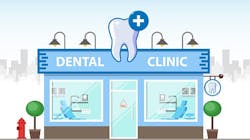A closer look at common practice valuation approaches: Asset-based approach
Editor's note: This is part two of a four-part series on practice valuation approaches. Read part one here.
Determining business value is a complex procedure, because it requires applying multiple methodologies so that the outcome of the valuation process is not “contaminated” by statistical bias or objective influences.
As we mentioned in our previous articles, most business owners can precisely assess the worth of their practice’s tangible assets, such as dental equipment, instruments, computers, and other assets. However, such assessment often remains subjective, imprecise, and debatable, which naturally leads to unnecessary and perhaps uncomfortable questioning of the value of business assets.
In this article, we’ll explore the second approach to traditional valuation methods used for selling business assets—the asset-based approach. While this approach is more frequently used as a component of more complex valuation processes, it is sometimes used independently to arrive at a comprehensive valuation of a business listed for acquisition.
Asset-based valuation
The asset-based approach is undoubtedly one of the primary methods used in the valuation process, because it determines the value of an entity by assessing what all businesses have, namely assets and liabilities.1
This method is particularly useful for dental practices that have significant tangible assets, such as equipment and real estate, especially when income from clinical operations is neither significant nor mature. An asset-based approach is useful in acquisitions of newly formed practices or in cases of asset liquidation.
While other methodologies focus on business as a functional, income--generated entity, the asset--based method focuses on tangible assets. The asset-based method is more frequently used with other valuation methods—such as the income or market approach—than as a single methodology.2
The asset-based approach can provide a solid foundation for practice valuation, but it will not capture the total value of the practice’s intangible assets, such as brand reputation, patient relationships, and goodwill.
Types of asset-based valuation
The asset-based approach to valuation assesses the business’s value (a dental practice, in this case) by analyzing its assets and liabilities. This method is beneficial for practices with significant tangible assets (i.e., those assets found on the practice’s balance sheet).3
The asset-based approach generally considers two primary valuation methods:
- Book value method: This method estimates practice value by subtracting the liabilities from the assets, which are typically recorded on the practice’s balance sheet at historical cost. However, historical costs may not reflect the current market value of the assets. While the current value of real estate may be higher than the historical value, the value of other tangible assets (such as dental equipment) may be lower than the book value. That’s where the following method comes in.
- Adjusted book value method: This is a variation of the standard book value method designed to improve the accuracy of calculations to reflect the current market value of the assets by applying appropriate adjustments to the historical costs. This modification of the book value method requires the help of experienced appraisers to formalize each asset’s current values.
- Liquidation value method: As the name states, this method determines the value of a business by estimating the proceeds that could be received if all assets were sold and all liabilities were paid off. Unfortunately, this assumption is based on the premise of a forced-sale scenario when all business assets are being liquidated, voluntarily or not.
- Orderly liquidation value versus forced liquidation value: Orderly liquidation value is an estimate of what the assets would sell for, given the seller can sell them over time (typically at least several months) in an orderly manner without significant discounts. Conversely, forced liquidation value is based on a more aggressive estimate, assuming the assets must and will be sold immediately (probably through foreclosure sale), often resulting in significantly lower prices due to the urgency or “forced” nature of the sale.
While the asset-based valuation method is perhaps the most mathematically rigorous and, therefore, provides the most conservative estimate of practice value, it, like most others, has its benefits and disadvantages.
Benefits of asset-based approach
The benefits of the asset-based approach to valuation are based on the method’s mathematical accuracy and simplicity of application:
- Simplicity and objectivity: In comparison with other valuation approaches, the asset-based method is relatively straightforward and objective. It relies on verifiable data derived from the practice’s financial statements, eliminating less reliant, subjective assumptions or projections.
- Reliance on tangible basis: The asset-based approach focuses on the practice’s tangible assets, such as real estate, equipment, and cash. This method is particularly suitable for asset-rich practices where tangible assets play a significant role in generating revenue or eliminating the time and cost commitment associated with constructing or setting up a new practice.
- Conservative nature of value estimate: Since this valuation method primarily considers the net value of the assets after deducting liabilities, it typically yields the most conservative estimate of practice value, reducing subjectivity and the risks associated with the valuation process.
- Usefulness in distressed situations: Not all practice sales are equal. The asset-based approach is especially relevant in situations such as bankruptcy or liquidation. It helps the seller understand the minimum value they might expect to recover from selling the practice’s assets and provides the potential buyer with a relatively sound basis for decision-making in acquisition, restructuring, or winding down operations.
- Complements and validates other valuation methods: In addition to capturing the value of intangible assets and providing a minimum floor value of enterprise, the asset-based approach complements other valuation methods (such as the income approach or market approach), which allows practice value to be built on the foundation provided by the calculations.4
Disadvantages of asset-based approach
The asset-based approach to valuation also has some notable disadvantages:
- Limited consideration of intangible assets: Since the asset-based approach primarily focuses on tangible assets such as real estate and equipment (when it relates to dental practices), it does not adequately account for the value of intangible assets such as practice reputation, the value of goodwill, or intellectual property and patents (if the practice holds any). In a traditional dental practice or DSO, intangible assets play a significant role in generating revenue, so relying solely on the asset-based approach may result in substantial undervaluation.
- Historical cost basis and depreciation/amortization: The fact that the practice’s assets are typically recorded on the balance sheet at historical cost rather than at their current market value may lead to undervaluation of certain assets, such as real estate, which more frequently appreciates over time. On the other hand, applying depreciation and amortization to the book value of tangible assets reduces their value over time due to depreciation (for tangible assets) or amortization (for intangible assets). Such accounting procedures can result in understating the actual economic value of the assets, particularly if they have a longer useful life or if their market value exceeds their book value. Adjustments may be necessary to reflect the fair market value of assets, which can introduce subjectivity into the valuation process.
- Limited consideration of future cash flow: The asset-based approach’s limited focus on tangible assets restricts its ability to recognize the economic potential of a business enterprise. This method does not consider the practice’s future cash flow or earnings potential. A functioning dental practice is a “going concern” enterprise; therefore, ignoring or discounting its economic potential may result in undervaluation of practices with strong growth prospects or innovative business models.
- Off-balance sheet items: The asset-based approach considers the value of the assets, but it may not fully account for the practice’s liabilities or off-balance sheet items. Liabilities frequently include private loans from the owners that are not reflected on the balance sheets. This can lead to inaccurately recorded liabilities or assets that have a lower net asset value than what is reflected on the balance sheet, contributing to an inaccurate valuation.5
Are businesses worth more or less than asset value?
Understanding how business worth—also known as enterprise value—relates to valuation is essential. According to Paul Wormley, “In nearly every case, a successful company with good cash flows will have an enterprise value that exceeds its asset value.”6
The reason for this is that while enterprise value is based on multiple valuation approaches and is more comprehensive, the book value is primarily determined by the value of the assets alone and tends to understate the market value of the business. This happens because intangible assets, such as reputation and goodwill, don’t show up on the balance sheet and thus are not included in a calculation of book value. In contrast, a practice’s enterprise value can exceed its asset value due to the fact that the intangible asset value is bound to the creation of repeatable profits and cash flow.
What is the main reason for calculating the market value of assets, especially if they are not particularly relevant to the market value of an enterprise? The answer is simple. “A large asset base is important in the sale of a small business because it provides a buyer with the collateral necessary to obtain financing from a bank.”6
Wrapping up
The asset-based approach provides a conservative estimate of dental practice value. It can be used as a stand-alone method or in combination with other methodologies. As a stand-alone method, it can be useful in certain scenarios, but its limitations must be considered. When it complements other valuation methods, a comprehensive understanding of the method is essential to truly assess its weight when determining practice worth.
The asset-based approach is particularly relevant in circumstances such as liquidations, expedited sales, bankruptcy proceedings, or when the practice’s earnings do not reflect its underlying asset value. While limitations may hinder one from fully capturing the value of intangible assets such as practice reputation, patient relationships, or practice goodwill, this method is often used in conjunction with other valuation methods (such as the income approach or market approach) to arrive at a comprehensive valuation.
Overall, the asset-based valuation approach offers a conservative and reliable method for assessing practice value, particularly when tangible assets play a significant role or when other methods cannot fully capture the practice’s value due to external circumstances that may limit future economic projections.
Editor's note: The article appeared in the September 2024 print edition of Dental Economics magazine. Dentists in North America are eligible for a complimentary print subscription. Sign up here.
References
- Sweeney D. Asset-based valuation and market value approach: what’s the difference between these valuation methods? SCORE Association. June 13, 2024. https://www.score.org/resource/blog-post/asset-based-valuation-and-market-value-approach-what%E2%80%99s-difference-between-these
- Young J. Asset-based approach: calculations and adjustments. Investopedia. October 28, 2020. https://www.investopedia.com/terms/a/asset-based-approach.asp
- Grau D. Asset valuation methods: the different methods and roles. Succession Resource Group. March 1, 2022. https://www.successionresource.com/blog/asset-valuation-methods
- Tamplin T. Asset-based valuation. Finance Strategists. Updated August 1, 2023. https://www.financestrategists.com/wealth-management/valuation/asset-based-valuation
- Asset-based valuation – methods, pros & cons. Jaro Education. 2022. https://www.jaroeducation.com/blog/asset-based-valuation-methods-pro-and-cons
- Wormley P. Asset-based valuations: benefits and pitfalls. Hadley Capital. October 20, 2021. https://www.hadleycapital.com/insights/selling-a-small-business/my-business-is-worth-less-than-its-asset-value
About the Author
Edward Ruvins, DDS, MBA, MS, MSAC, MSF
Founder of Spectrum Dental Group and Optimum Consulting Group
Edward Ruvins, DDS, MBA, MS, MSAC, MSF, FAAID, DABOI/ID, DICOI, DIDIA, CFE, CVA, is a graduate of New York University. He holds master’s degrees in oral implantology, health care administration, finance and investments, and addiction counseling. He is a founder of Spectrum Dental Group and Optimum Consulting Group. Dr. Ruvins is a certified valuation analyst and a certified fraud examiner. Contact him at [email protected].

Mark Stein, DDS, MD
Mark Stein, DDS, MD, completed his training in oral and maxillofacial surgery at the University of Medicine and Dentistry of New Jersey during an intensive six-year residency program. He’s the owner of New York Oral & Maxillofacial Surgery/Dental Implant Center. Dr. Stein has been an assistant professor of oral and maxillofacial surgery at New York University and an attending physician at Columbia University Medical Center, Staten Island University Hospital, where he’s involved in resident training and education in the dentistry and surgery department.

Susanna Kayserman, DDS
Susanna Kayserman, DDS, has been practicing cosmetic and restorative dentistry since 1995. She is a graduate of New York University College of Dentistry and an active member of the American Dental Association and the Academy of Osseointegration. She has been involved in teaching residents as an attending at Staten Island University Hospital and was actively involved in her local dental society.


